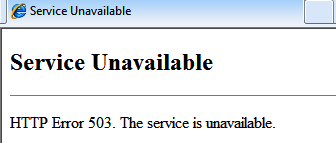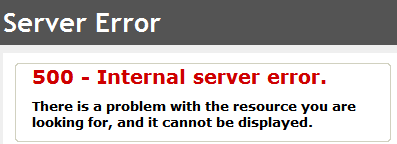Interview :: SEO
The "503 Service Unavailable" error is an HTTP status code which indicates the server is not available right now to handle the request. It often occurs when the server is too busy or when maintenance is performed on it. Generally, it is a temporary state which is resolved shortly.

The "500 internal server error" is a common error. It is an HTTP status code that indicates something is wrong with the websites' server, and the server is not able to identify the problem. This error is not specific as it can occur for different reasons. It is a server-side error which means the problem is with the website's server, not with your PC, browser or Internet connection.

Image Alt text is a feature which is added to an image tag in HTML. It appears in the blank image box when the image is not displayed due to slow connection, broken URL or any other reason.

It provides information about the image to the search engines as they cannot see or interpret images. Thus, it enables you to optimize images or improve the SEO of your site.
Google analytics is a freemium web analytics service of Google that provides you the detailed statistics of the website traffic. It was introduced in November 2005 to track and report the website traffic. It offers you free tools to understand and analyze your customers and business in one place.

It mainly comprises statistics and basic analytical tools capable of monitoring the performance of your site. It tells you various important things about your website like your visitors, their activity, dwell time metrics, incoming keywords or search-terms, etc.
Thus, it helps you take the necessary steps to improve the SEO of your site and online marketing strategies. Anyone with a Google account can use this tool.
The reports generated by Google analytics can be divided into four different types of analysis which are as follows;
- Audience Analysis
- Acquisition Analysis
- Behavior Analysis
- Conversion Analysis
Audience Analysis: It gives you an overview of your visitors. Some of the key benefits of this analysis are as follows;
- It tells you the age, race, gender of your visitors.
- You can find the location and language of visitors.
- You can identify the new visitors and returning visitors.
- You can identify browsers, operating system and the network of visitors.
- You can see Visitors' activity; the path they follow on your website.
Acquisition Analysis: It helps you to identify the sources from where your website traffic comes. Some key benefits of this analysis are as follows;
- You can track traffic from a paid search such as AdWords.
- You can capture traffic from all channels including referrals.
- You can track social media traffic, hub activity and can follow-up bookmarking sites.
- You can identify from which plug-ins you are getting traffic.
- You can analyze and manage your campaigns.
Behavior Analysis: It helps you monitor users' behavior. It offers you the following benefits;
- You can generate a content drilldown report which will give you a crucial perspective on site usage and information about landing and exit pages.
- You can measure page timings and user timings which will suggest you the ideal site speed.
- You will know how the users move across your site, what they normally search before arriving at a landing page.
Conversion Analysis: Website conversion analysis is an important part of the SEO process. Every website has a particular goal such as to generate leads, to sell products or services, to increase targeted traffic. When the goal is achieved, it is known as conversion. Some major benefits of this analysis are as follow;
- It enables you to track conversions such as download, check out, buy, etc.
- You will know which of your products the users buy the most.
- You can generate multi-channel funnel reports from conversion paths.
- You can identify which module, platform, and strategy are best for your business.
We can check which pages of a website are indexed by Google in two different ways:
- The first method is to check the Google index status of the website through Google Webmaster tools. For this, you are required to add the website on the dashboard and verify the ownership then click on the tab "Index status". The webmaster tool will display the number of pages indexed by the Google.
- The second method involves a manual search on Google. In this method, you are required to type on Google search bar site:domainname.com. The indexed pages would reflect on the SERP.
PageRank is one of the important ranking factors that Google uses to rank the web pages on the basis of quality and quantity of links to the web pages. It determines a score of a webpage's importance and authority on a scale of 0 to 10. A webpage with more backlinks will have a higher PageRank than a webpage that has fewer backlinks. It was invented by Google's founders: Larry Page and Sergey Brin.
Note: At present, Google is not using PageRank as a ranking factor or to rank a webpage.
The Page rank of your page indicates the performance of your page. The page rank of a page depends on many factors such as quality of content, SEO, backlinks and more. So, to increase the page rank of a website you have to focus on multiple factors, e.g., you have to provide unique and original content, build more backlinks from authority sites and web pages with high page rank and more.
The Domain Authority is a metric introduced by Moz. It is designed to rank a website on a scale of 1-100. The score "1" is considered the worst and the score "100" is considered the best. The higher the score or DA, the higher will be the ability to rank on search engine result pages. So, it is an important factor that defines how well your website will rank in search engines.
A blog is an information on the website that is regularly updated. Blogs are usually written by an individual or a small group of people. It is written in an informal or conversational style.
It is like an online diary or a book located on a website. The content of a blog generally includes text, pictures, videos, etc. A blog may be written for personal use or sharing information with a specific group or to engage the public. Furthermore, the bloggers can set their blogs for private or public access.
Some of the most used social media channels are:
Blogging Platforms: Blogger, WordPress, Tumblr , Medium, Ghost, Squarespace, etc.
Social bookmarking sites: Digg, Jumptags, Delicious, Dribble, Pocket, Reddit, Slashdot, StumbleUpon, etc.,
Social networking sites: Facebook, WhatsApp, Instagram, LinkedIn, Twitter, Google+, Skype, Viber, Snapchat, Pinterest, Telegram, etc.
Video Sharing sites: YouTube, Vimeo, Netflix, Metacafe, Liveleak, Ustream, etc.
